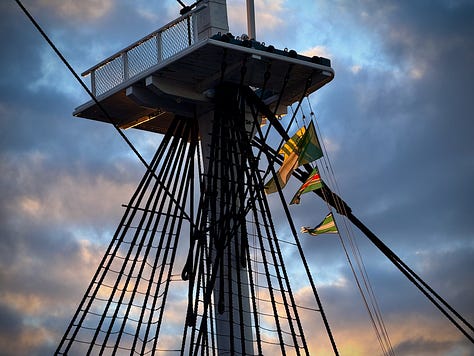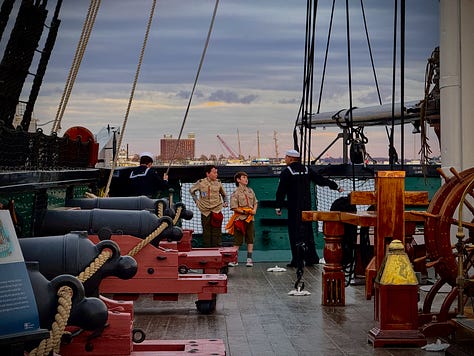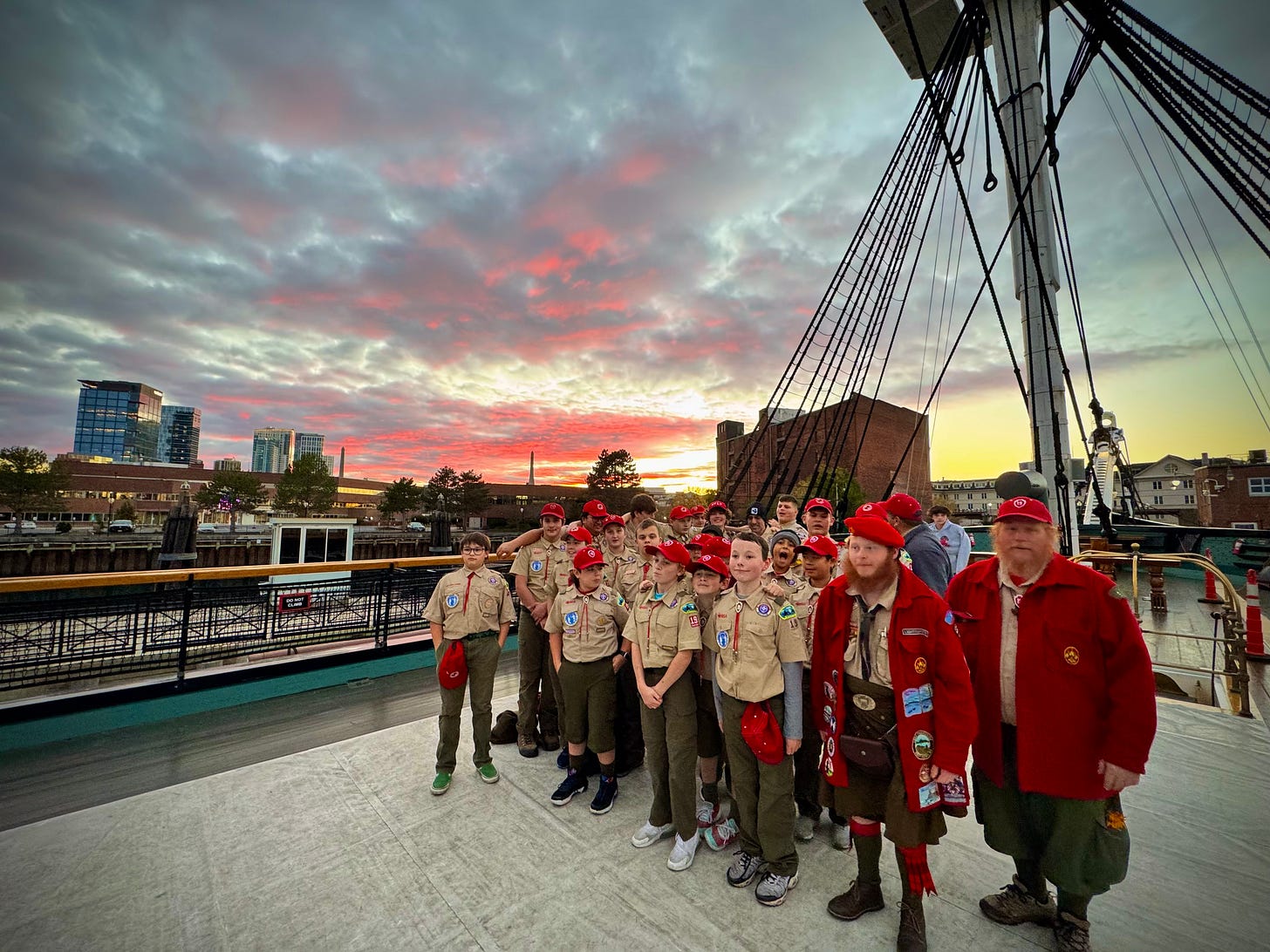On Deck with the Past: A Scout Troop’s Adventure Aboard the USS Constitution
History, Hauntings, and Heroism on America’s Most Storied Warship
I had an incredible opportunity this weekend to visit the USS Constitution with my sons' Scout troop. In case you don’t know, the Constitution is the oldest commissioned warship in the world, having been in active service since 1797. She is a three-masted, square-rigged frigate rated for 44 guns as-built. She is berthed afloat in Boston Harbor with an active-duty US Navy crew. She still ventures forth from her berth several times a year, including her annual turnaround cruise on the 4th of July to ensure even weathering. The last time she sailed under her own power was in 2012 to commemorate the 200th anniversary of her victory over HMS Guerriere.
I had the privilege in 2013 of being aboard for her July 4 turnaround cruise. My dad knew one of the former captains who invited him to be aboard and he brought me along. One of the coolest parts of that day was during the piping-aboard ceremony when dignitaries were piped aboard in order of precedence with appropriate salutes. After all the admirals and government officials, the last to be piped aboard were Medal of Honor winners (the Medal of Honor Society was meeting in Boston that week) who received a 21-gun salute and the loudest cheers and applause. I will never forget that day and will always cherish the US flag I have that flew from the halyard. (They ran a series of flags up the line and sold them to people aboard, I think as a fundraiser for the museum, which is a private nonprofit organization.)
Literary Anchors
I’ve read several books that include or involve the Constitution. From the nonfiction side was Six Frigates: The Epic History of the Founding of the US Navy, by Ian Toll. This was a great primer on the beginning of the Navy and specifically the first ships commissioned and built for the Navy, including the Constitution. The stories involving the early exploits of the Navy, especially in the Mediterranean against the Barbary Pirates, were especially thrilling. If you’re familiar with the Marine Corps, this is where “the shores of Tripoli” comes from. The great European powers had for centuries found it easier to pay off the pirates to protect their shipping from depredation than to root out the pirate states, which were under the protection of the Ottoman Empire in Istanbul. The fledgling United States was likewise paying off the leaders of the North African states in what are now modern-day Libya, Algeria, and Morocco to keep their hands off American ships, which they only mostly did.
In 1803, while chasing a Tripolitan ship into Tripoli, The USS Philadelphia–Constitution’s sister ship–ran aground on a reef. Unable to refloat the ship, the captain, William Bainbridge, had to surrender it to the Pasha of Tripoli and he and his crew were imprisoned. American leaders thought the Philadelphia could not be left in enemy hands, not only because it was too great a weapon to be turned against us, but also because it was a blow to American prestige. So the commodore devised a plan to use a captured Tripolitan ship with an American crew aboard to sneak into Tripoli’s harbor and, if the Philadelphia could not be recaptured, she should be blown to smithereens. The subsequent operation led by Lt. Stephen Decatur was so daring that the whole affair should be made into a movie. And, of course, the Constitution was there as the flagship of Commodore Preble.
This episode is a key part of a second book I’ve recently read that concerns the USS Constitution. The Shores of Tripoli by James Haley is the first book in the Bliven Putnam Naval Adventure series, about a young man who becomes a naval officer in the US Navy at its beginnings. It’s a fine book that I would like to recommend for young people, except for one scene near the end which involves Putnam engaging in an inappropriate encounter with a young woman. Until that point, the book did a fine job of giving you a sense of what the world was like and how people of that time acted and thought in a way that was accessible to teens. It’s a shame that Haley had to include the one scene that seemed entirely unnecessary to me.
Apart from that, we get to see Putnam’s service aboard both the schooner Enterprise and the frigate Constitution, including in several actions. He also serves ashore as the liaison for the Marines who would fight in the Battle of Derna, in which US Marines led a mercenary army against a larger force in the successful battle commemorated in that “shores of Tripoli” line.
The book was good although I’d wished to have a little more action at sea, but Haley was limited by the Constitution’s actual service as this was historical fiction trying to adhere to the real history as much as possible. But what I especially enjoyed was the description of the ship herself, life at sea, and how it was sailed.
Tales from the Orlop: Ghost Stories on the High Seas
As I said, all of this discussion of Old Ironsides was prompted by the opportunity to go aboard the ship this past weekend with my sons' Scout troop. Originally, we were to sleep aboard the ship overnight, but the overnight temperatures were going to be lower than they allow, which is a shame because Scouts know how to sleep in the cold. Nevertheless, we got a special tour of the ship led by three of her sailors. They drilled with boarding pikes, participated in Colors at sundown, watched the troop flag and the troop’s US flag run up the lines during Colors, got to go aboard the ship into areas not normally open to the public, including the captain’s cabin and all the way down to the keel in the magazine and orlop. The Scouts also had a time where they could ask the sailors questions and I asked about whether they had any ghost stories, of course.
All three sailors said they had seen and heard strange things during their overnight watch standing, especially at 3am. One said when he was making his rounds, he was down in the orlop checking on the bilge pumps, when he heard very distinctly the sound of someone walking on the deck above him even though he knew no one was aboard when was just up there and there was still no one when he went back up. The two female sailors both reported seeing one among the many hammocks on the berthing deck swinging by itself. If it had been wind or even waves (which is nigh impossible since the ship does not move at her berth), all of the hammocks would swing. One of the sailors said one night after it had rained, she was standing watch and was checking on the blower fans they use to dry the belowdecks. She emphasized that there was no wind and that the fans plug into outlets in the overhead, but when she came down to the deck she saw all the cords whipping about wildly. Creepy! I’m sad that I couldn’t stay aboard and see if anything creepy happened that night.
The Constitution remains one of my favorite sites in all of Boston and I look forward to seeing her all spruced up for both the 250th birthday of America in 2026 and the ship’s 230th birthday in 2027. If you ever get a chance to visit Boston, don’t miss her.














What a vivid account. I’ve been writing recently about the USS Philadelphia and the First Barbary War, and it’s striking to think how vessels like the Constitution weren’t just symbols, but keystones in America’s early assertion abroad. The continuity from that era to moments like your July 4 cruise really underscores how memory and maritime power remain linked.